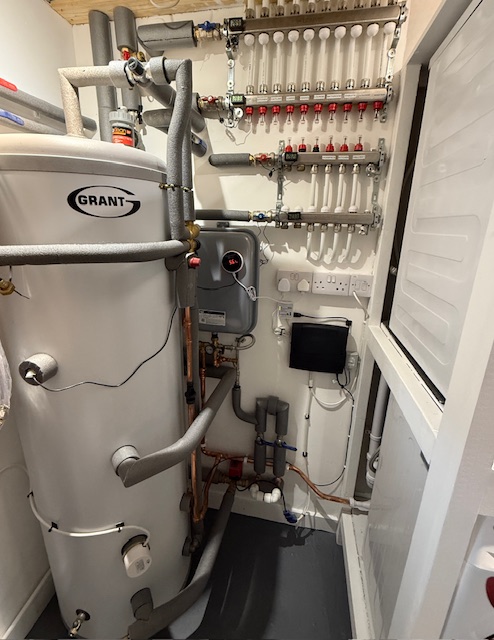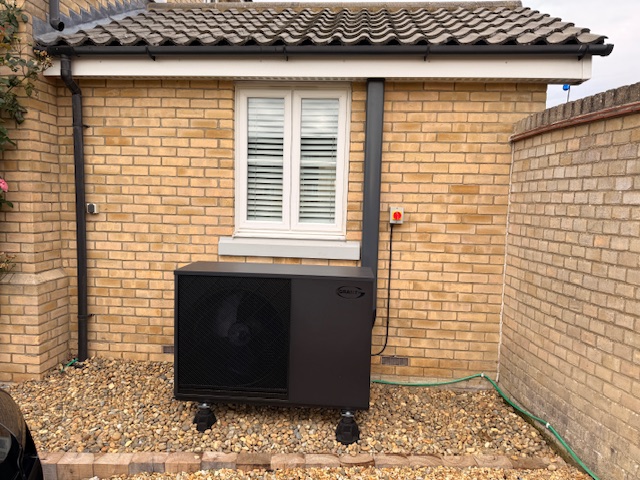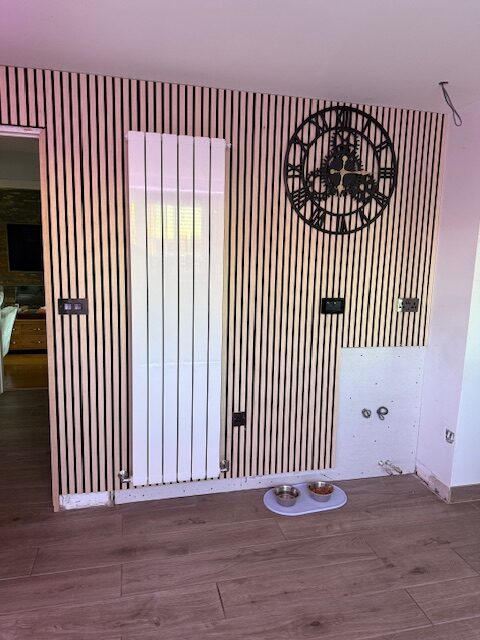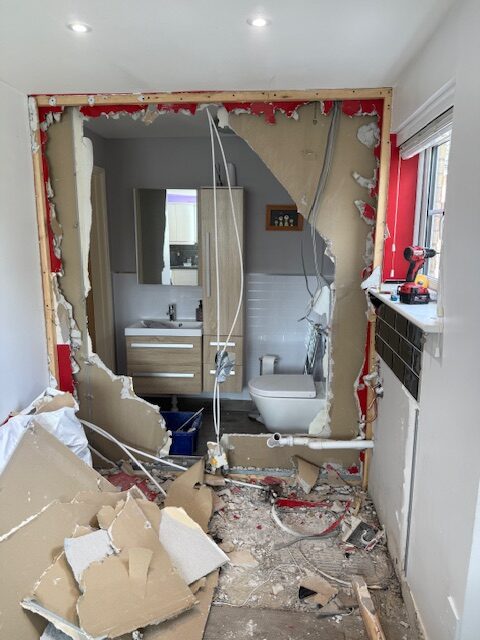Our Home Heating Upgrade Great Cambourne
As far back as 2005, our Business was undergoing Training with Heat Pump manufacturers to better understand the latest technologies in offering from some of the best names in Air Conditioning Systems, it wasn’t until 2009 that our very first Heat Pump was installed – a system that is annually maintained and still operating without issue, although this unit was originally replaced along with 5 others we fitted in that period due to safety concerns.
Fast forward to 2025 with a high number of Heat Pumps Installed to date, it was time to look at my own home a 2006 Build 4 Bedroom Detached.
Taking all of my experience and that of my Teams Heat Pump Training, we set about trying to find the most efficient system but balancing the cost against the disruption that would occur.
My Wish List
- A Quality Heat Pump with Long Warranty, good modulation range
- Smart Controls and App control
- Aesthetically appealing look and placement of said Heat Pump
- At Least 250 Litres of Store Water with high recovery (4/5 people)
- Underfloor Heating on Ground Floor (possibly throughout)
- Designer Aluminium radiators on 1st floor
- Lowest sensible Radiator Temperature, 45 degrees @design outside of -3 at 21 internal throughout
- Replacement of existing Microbore Plastic Heating Pipes
- Open loop Design
- No Buffers or Volumizers
- A Warm House, but efficient in operation
- Ability to extend the system for future Building works
The Existing Heating
Our existing System had a Viessmann 111 Storage Combination Boiler, and it was installed in 2014 so was just over 10 Years old (2nd Boiler) , we had traditional Stelrad Single and Double panel Convectors throughout with Towel Rads in Bathrooms, with a Kick Space Heater in the Kitchen. The radiators had Smart Thermostatic radiator Valves from Honeywell.
We like a warm Home and quite often 21 Degrees felt at times cold – so it wasn’t uncommon to see higher temps in the home especially when it was cold and miserable outside, our Adult Son and Daughter would spend a lot of time in their bedrooms so again warmer daytime and cooler night-time temps where important considerations.
Hot water had never been an issue, as the Store Boiler could just pump out 45 degrees all day long, although we did lose Hot water once for 12 hours – what a drama…..
All in all, a great system but a big jump in operating costs when the price of Gas Double/Tripled and one of our drivers for reducing our running costs against that of Gas.
The Design
We deliberated about underfloor heating throughout, but the disruption was just too great to bare, our ground floor is a mix of tiled and wood floors, and our upstairs was newly carpeted a few years ago and I wasn’t quite ready to redo it all again.
We future proofed our Home by installing underfloor heating manifolds in a central location with individual flow and return pipes to each and every radiator, allowing us the option to switch to underfloor if we so wished. This was probably the most intrusive as we had to access the floors in each bedroom to install new 16mm MLCP pipework, as well as chasing new pipes into the walls for some of the ground floor radiators. We also have the ability to extend the system into a planned home extension.
Installing the pipes took two days for 4 engineers – no joints and over 150mtr of pipe installed.
We opted to have all rooms heated to 21 at ambient of -3 with a flow of 45 degrees, Radiators selected as close as possible to match the demands of each.
The Heat Pump chosen will deliver 9kw at -5 degrees at 55 flow temperature, the next model down did not meet our needs or demands – our Heat Loss was 7050 watts without our planned extension and 8400 with.
We use Spruce Eco Software for our Heat Loss – intuitive and continually developing.
Hot Water
The Hot Water System and location was a bit more involved, initially we reviewed.
- Roof Installation
- Reuse Boiler Cupboard
The Roof Installation would have needed Structural Work to be completed, installing 300kg of weight onto modern trusses needs specialists’ guidance, the old cupboard that housed the Boiler would have needed a bespoke cylinder due to height restriction.
The end result was to demolish a wall between our kitchen and downstairs WC and create a Lootility Room, this room now houses the washing machine and tumble drier, WC and Basin including cabinets, a 250 litre Grant Quick Recovery Cylinder (Latest Generation) , manifolds for heating, system controls, water softener, additional electrical consumer units.
This has lead to a redesign of our Kitchen Breakfast Bar and some additional work, but all for the better we feel. (job for Winter)
The Heat Pump
We are fortunate that we had several locations available for a Heat Pump, in the end we opted for an east facing location on the side of the house discharging across our driveway with zero chance of noise disturbance, you cant hear it running anyway !! and it will give better operating figures as it’s the warmer side of the house, Good access route into the House and out of the way.
Our Unit of Choice was either the Grant Aerona R32 or the latest Grant R290, we opted for the Grant R290 9KW Version with Smart Controls, we have fitted quite a few now and have been very impressed by its all-round operation, ease of control, simplicity, looks but above all a Great Company that we have associated with for over 25 Years.
Our first Aerona 3 Heat Pump was installed in 2018, followed by the R32 as our mainstay and more recently the R290 which is our go to heat pump, having installed over 80 units to all differing properties we can vouch for the reliability and performance of the R32 and R290 units.
The only issue with the R290 is distances required around the unit, I have had to temporarily blank off some air vent to stop any possibility of Refrigerant escape into the Home, I am looking at options such as a ducting but am also hopeful that our new extension will negate the need long term.
Antifreeze additives can not be used in an R290 Unit, so we have installed an Antifreeze Valve for protection of the system, we do hope to have batteries Installed which would negate the need for Frost Protection as power loss to the home is our only concern, and almost certainly the only time that the system would be at risk.
The Antifreeze Valve (Inta Zero) from Intatec is a supplier of choice, this along with the Insulation from Primary Pro ensures we protect against extreme temperatures.
We prefer to install our External Pipework within a Plastic trunking, so when we do use products from our supply chain, we can accommodate colours White, Black, Anthracite Grey to match aspect of the home.
We Installed 28mm Primary Flow and Return pipes from the Heat pump to the newly located Cylinder within the Lootility Room, because the pipes had the potential to trap air, we installed 2no Inta Vent Automatic Air Eliminators at the highest point ensuring all air could be released from the system.
Using the Grant Smart Controls, with HWS Priority 3 Port Valve ensures we always have Hot water available. The new QR 250 Cylinder is different in that the Flow to the Cylinder connects at the bottom, with the return at a much higher level, The Coil within the cylinder has a much larger surface area of 3.8m, a bit more than its predecessor, giving a much-improved recovery.
Our very first run at commissioning raised the temperature from 15 degrees to 55 degrees in 1 hour and consumed 2.83kwh of energy (24p x 2.83 = 67pence)
We have an EV tariff which provides electricity at 6.38p nighttime and 24.17p daytime.
We heat our water to 55 degrees at night so potentially costing 18 – 25 pence for a full tank, we also do a daytime top up to ensure we have enough for nighttime showers. Rarely does the tank require a full reheat.
The Heat Pump can deliver much higher temps, I have chosen not to automate the Legionell cycle and it has been separated from the Smart Controls at present. I have an independent Time Control with Consumption meter fitted so I can monitor and automate a weekly boost to prevent against Legionella Bacteria – our Hot Water Outlet is restricted by the use of a TMV Blending valve ensuring no danger of scalding.
We have installed a Temp Sensor at the higher-level sensor pocket, which alerts us to low temps at the top of the cylinder so we can if needed override the controls, we choose this way to ensure the most efficient cost/times for energy.
Stratification of the cylinder has been good with only minimal temp differences between top and bottom on full reheat, two showers down, high level is still showing 50 degrees but at lower level point its much less at 20/25 degrees.
Battery Storage is our next step to lower fuel costs.
The Heating System
After deliberations about under floor heating, and taking the route of least upheaval – we opted to purchase the Grant Affinia radiators for the Living and Bedroom areas, the Heat being generated has amazed us even though the water temperature has rarely risen above 30 degrees since switch on – during our commissioning test we set the system to run at 45 degrees fixed temperature and set our flow rates around the radiators to achieve our required output. The system is now set to run on Weather Compensation adjusting the water temperature automatically based on the ambient air temperature, The Inbuilt Circulating Pump is a Modern variable speed that automatically fluctuates to deliver our required Delta T of 5 degrees and ensures the Heat Pump Compressor can operate for longer periods of time without shutting down. The unit has been modulating down to consume only 400watts of power per hour, and in Hot Water mode consuming around 3kw/hr providing over 10kw of Heat.
We have set the internal temperature to a much higher requirement of 22 and we are now playing with the Weather settings to obtain an optimum temperature range so in effect the room stat becomes a temperature limiter.
The Bathrooms we retained the Towel radiators for now, having just recently installed Electric Underfloor Heating to one bathroom and about to do the second – we may decide to update these having completed a winter of operation.
An existing designer radiator was reused and is now heating the Lootility, far to big for the space but didnt want to waste such a nice rad. the Flow rate has been reduced to match the room demand.
We have the option to install a Kick Space Heater within our Kitchen/Breakfast room but again a winter test will tell me, the heat demand will be met but if and when we open an Extension we may need to install the kick space unit to save installing more than 1 additional radiator.
eager to learn and adapt, our Heating was switched on in September – there has been interesting external variables and nighttime temps, and the heating is now operating on a daytime 22 and nighttime set back of 19.5
We took the choice for Open Loop as last winter we removed all of the Radiator Heads and adjusted operating times to reflect our occupancy as opposed to setting individual room temps and allowing the Boiler to operate on demand. The House felt warmer and had 2 operating temperatures similar to those we have now.
We also wanted to keep out unnecessary items such as Buffers or Volumizers for space saving, which also decreases costs.
We will continue to play over the coming months to achieve low flow temps but ensure we achieve our comfort levels, after nearly two months we are recording 450% efficiency for hot water generation, in Heating mode on the display we are seeing value upwards of 650% – total SCOP to date 7.3.
what does COP mean Coefficiency of Performance
The Coefficient of Performance (COP) measures a heat pump’s efficiency by comparing the useful heat output to the energy it consumes, expressed as the ratio of output to input energy. A higher COP indicates greater efficiency, meaning more heat is produced per unit of energy consumed. For example, a COP of 4 means the system provides 4 units of heat for every 1 unit of electrical energy used.
SCOP is the seasonal efficiencies – Total of all combined
Whilst the efficiencies in HW mode could be improved, I am trying to balance the cost on nighttime rates against daytime rate. We also have the colder temperatures coming in due course.
Summary
We have Installed a number of good Quality Heat Pumps over the past ten Years, Initially Mitsubishi Ecodans, followed by the Grant Aerona 3 and R32 units, Viessmann and Vaillant and now the latest generation 5 Heat Pump R290 from Grant UK.
The R290 is now our go to Heat Pump, it performs to a very high efficiency, The Badged Capacity is factual and meaningful, with the addition of Smart Control and App functionality allows us to review performance for all of our customers and make changes to obtain the best results possible, the units appearance is pleasing to the eye. The Unit is packaged well to protect against damage – but care must be taken with the unit once on site as the panels can be scratched easily.
The Installation was straight forward, the wiring layout is simplified with the smart controls, as was the commissioning process.
The Specification
| Product Type | Description |
| Heat Pump | Grant Aerona R290 9KW |
| Cylinder | Grant QR250 Latest Generation High Recovery Coil |
| Controls | Grant Smart Controls – HWS Priority open loop |
| Radiators | Grant Affinia Horizontal and Vertical (also reuse existing) |
| Heat Pump Hoses | IntaFlex |
| Radiator Valve | Inta CP Corner radiator Valves |
| Antifreeze Valves | Inta Zero 28 |
| Magnetic Filter | IntaKlean IKHPMF Filter |
| Isolating Valves | Inta K Type Ball Valves, Inta Lever Valves |
| Fill and flush | Inta 28 Fill and Flush Valve |
| Air Separator | Inta 28mm Vent Deaerator |
| Expansion Vessel | Intafil 24 ltr Slimline Kit |
| Pipe | Copper Tube, MLCP for all radiator Circuits |
We have been very impressed with the operation, ability to make minor changes to improve running costs, and after nearly two months of operation we have reduced our consumption.
We will update this page to reflect actuals over the next 12 months.
having Installed a Heat Pump which we can monitor and learn to live with, we hope the data and info gleaned from our experience will help us guide our Customers in their own transition to Heat Pumps from Gas, Oil and Electric systems.
David & Angela Oct 2025
Grant QRSC250 Next Generation Heat Pump Cylinder within the New Lootility Room

Grant Aerona R290 9KW Heat Pump, Anthracite Trunking and Primary Pro Insulation (Air Bricks Capped off Temporarily)

The New Unfinished wall of the Lootility, awaiting the Breakfast Bar relocation

The Old wall Removed and Rebuilt creating a Larger Room housing the Washing Machine, Tumble Drier, Water Softener, Hot Water Tank, WC and Basin






